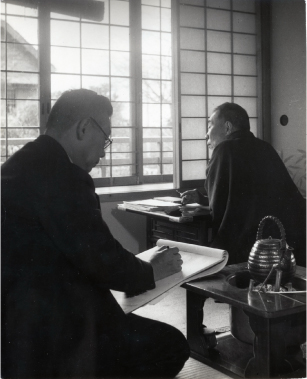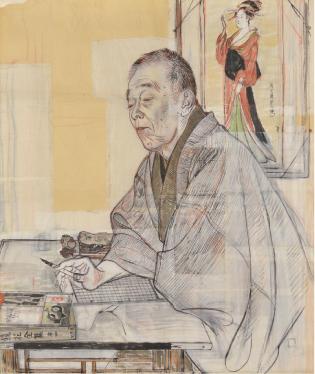MENUCLOSE
Nihonga Painters in Kamakura
Modern Era Nihonga Painters in Kamakura
Kamakura prospered after Minamoto no Yoritomo (1147-1199) established the seat of his shogunate here. In the Kamakura period, the city was also an important center for Zen Buddhism; its Zen temples disseminated the culture of Zen across Japan.
In the mid-Edo, when travel became popular among the common people, pilgrimages to Oyama and Enoshima as well as Kamakura, with its numerous Buddhist temples and shrines, made them thriving travel destinations.
In the early Meiji period when people became increasingly concerned about hygiene and health, Kamakura, with its mild climate and lovely natural environment, was spotlighted as a health resort. When the Yokosuka Line between Ofuna and Yokosuka opened in 1889, ride time between Tokyo and Kamakura was cut to about two hours, turning the city into a bustling travel destination and a popular location for holiday homes because of that convenient access. The city continued to develop as a travel destination when the Enoshima Line between Fujisawa and Kamakura opened in 1910.
Many modern painters were also attracted to Kamakura because of its natural environment and the proximity to the sea and mountains. Toward the end of the Meiji period, Kuroda Seiki (1866-1924), a Western-style painter, set up a holiday home in the Zaimokuza district of Kamakura, where he produced a body of works inspired by the local landscape. His visitors there included Kume Keiichirō (1866-1934) and, other painter friends and his acquaintances. In the late Taisho era, Kishida Ryūsei (1891-1929) moved from Kugenuma in Fujisawa to Hase in Kamakura where he lived until the end of his life.
As for Nihonga (Japanese-style) painters, Ogura Yuki (1895-2000) moved to Kita-Kamakura in 1938. Searching for a quiet place to live, Maeda Seison (1885-1977) relocated from Tsurumi to Yamanouchi in Kita-Kamakura in 1939. The following year, Moriya Tadashi (1912-2003), a student of Seison, also set up his home in Yamanouchi. In 1951, Ōta Chōu (1896-1958) moved to the same area, and finally in 1972, Hirayama Ikuo (1930-2009) established his atelier in Nikaido where he lived until the end of this life.
In 1946, after the war’s end, Kaburaki Kiyokata (1878-1972) moved from Gotemba where he had been evacuated during the war, to Zaimokuza in Kamakura. In 1949, Itō Shinsui (1898-1972), one of Kiyokata’s students, also moved from Komoro, to which he had evacuated during the war, to Yamanouchi in Kamakura where he established his atelier, the Geppaku Sansō. Shinsui used to visit Kiyokata in Zaimokuza and painted a portrait of his mentor that highlighted his talent as an essayist.
In 1954, at the age of 76, Kiyokata set up his home at Yukinoshita where he spent the remainder of his life until his death at 93 in 1972. Kiyokata liked Yukinoshita: “The place is quiet when you stay indoors, but lively when you go out,” he said. Yukinoshita was, he found, the ideal place for him.
In Kamakura, now as in the past, Wakamiya-oji Street, Komachi-dori Avenue, and Kamakura Kaido are bustling streets, but take one step down a side street and you will find yourself in the quiet atmosphere of the ancient capital.
We hope you will enjoy not only the art but also Kamakura, its townscape and rich natural environment loved by modern painters.
In the mid-Edo, when travel became popular among the common people, pilgrimages to Oyama and Enoshima as well as Kamakura, with its numerous Buddhist temples and shrines, made them thriving travel destinations.
In the early Meiji period when people became increasingly concerned about hygiene and health, Kamakura, with its mild climate and lovely natural environment, was spotlighted as a health resort. When the Yokosuka Line between Ofuna and Yokosuka opened in 1889, ride time between Tokyo and Kamakura was cut to about two hours, turning the city into a bustling travel destination and a popular location for holiday homes because of that convenient access. The city continued to develop as a travel destination when the Enoshima Line between Fujisawa and Kamakura opened in 1910.
Many modern painters were also attracted to Kamakura because of its natural environment and the proximity to the sea and mountains. Toward the end of the Meiji period, Kuroda Seiki (1866-1924), a Western-style painter, set up a holiday home in the Zaimokuza district of Kamakura, where he produced a body of works inspired by the local landscape. His visitors there included Kume Keiichirō (1866-1934) and, other painter friends and his acquaintances. In the late Taisho era, Kishida Ryūsei (1891-1929) moved from Kugenuma in Fujisawa to Hase in Kamakura where he lived until the end of his life.
As for Nihonga (Japanese-style) painters, Ogura Yuki (1895-2000) moved to Kita-Kamakura in 1938. Searching for a quiet place to live, Maeda Seison (1885-1977) relocated from Tsurumi to Yamanouchi in Kita-Kamakura in 1939. The following year, Moriya Tadashi (1912-2003), a student of Seison, also set up his home in Yamanouchi. In 1951, Ōta Chōu (1896-1958) moved to the same area, and finally in 1972, Hirayama Ikuo (1930-2009) established his atelier in Nikaido where he lived until the end of this life.
In 1946, after the war’s end, Kaburaki Kiyokata (1878-1972) moved from Gotemba where he had been evacuated during the war, to Zaimokuza in Kamakura. In 1949, Itō Shinsui (1898-1972), one of Kiyokata’s students, also moved from Komoro, to which he had evacuated during the war, to Yamanouchi in Kamakura where he established his atelier, the Geppaku Sansō. Shinsui used to visit Kiyokata in Zaimokuza and painted a portrait of his mentor that highlighted his talent as an essayist.
In 1954, at the age of 76, Kiyokata set up his home at Yukinoshita where he spent the remainder of his life until his death at 93 in 1972. Kiyokata liked Yukinoshita: “The place is quiet when you stay indoors, but lively when you go out,” he said. Yukinoshita was, he found, the ideal place for him.
In Kamakura, now as in the past, Wakamiya-oji Street, Komachi-dori Avenue, and Kamakura Kaido are bustling streets, but take one step down a side street and you will find yourself in the quiet atmosphere of the ancient capital.
We hope you will enjoy not only the art but also Kamakura, its townscape and rich natural environment loved by modern painters.
-

Itō Shinsui sketches his master, Kaburaki Kiyokata at Kiyokata’s house in Kamakura.
ca. 1951
Courtesy of Katsuta Kazumasa -

Portrait of Kaburaki Kiyokata, Preparatory drawing (1951)
Our Collection